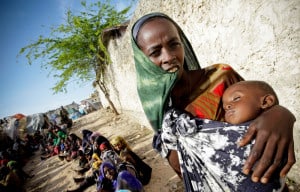
Is the world ready to watch 750,000 Somalis starve to death?
Starvation is the result of a severe or total lack of nutrients needed to sustain life. It’s easy for us to imagine the preliminary symptoms of weakness, irritability and fatigue. But what happens when that hunger is not remedied by food for days, weeks or even longer? Complete starvation in adults leads to death within eight to twelve weeks.
The process is painful as organs begin to shrink, cramping and severe muscle pain ensues, fluid retention and a drop in protein content causes the body to bloat, infections arise because of the loss of immune system response, hallucinations and convulsions become rampant and heart rhythm becomes erratic.
Can you imagine?
This summer, much of eastern Africa’s food production was destroyed by drought. This has caused a skyrocketing in food prices and the proliferation of famine. The results have been exceptionally devastating in Somalia, where the combination of the unforgiving drought, debilitating war, years of political chaos and restrictions on emergency aid have resulted in a food crisis for over four million Somalis.
The routes to refugee camps in Kenya, Ethiopia and Mogadishu are now being referred to as “roads of death”
The political environment in Somalia is violent, merciless and volatile. For 20 years, Somalia has limped along without an effective central government and has been widely accepted as the epitome of a failed state. In 2006, al-Shabab, one of Africa’s most formidable militant Islamist groups, took over much of southern Somalia.
Extremist al-Shabab supporters have been blamed for restricting the delivery of emergency food, water and medical supplies by aid organizations to famine victims. However, the African Union peacekeeping force overtook al-Shabab in Mogadishu, the capital of Somalia, in August, giving the central government authority of the nation’s capital. Although the transitional government is weak and al-Shabab remain in control of significant swaths of south and central Somalia, the central government says they are committed to helping famine victims.
However, now the situation has escalated into the world’s worst food crisis. The routes to refugee camps in Kenya, Ethiopia and Mogadishu are now being referred to as “roads of death” because of the emaciated bodies of those who have starved to death that lie along the roadsides as the Somalis seek safety and food. Most of them are children.
To add to the crisis the United Nations announced in August that a cholera epidemic is sweeping across the country. As the rains begin this fall, disease will germinate and spread long before any food can be produced. In addition to cholera, malaria, typhoid and measles are a short list of some of the diseases that will prey upon the malnourished and immune-suppressed populations. Last week, international aid agencies warned that the famine in Somalia is at a turning point as the environmental and health conditions decline. Hundreds of thousands of people are expected to die in the coming months.
Many NGOs who have worked in Somalia for decades say that although they are accustomed to the daily struggle that most Somalis face, they have never before faced such acute suffering with so many lives at stake. Is the world ready to watch 750,000 Somalis starve to death?
Canadians have donated, but not much. The international response to the famine falls drastically short of what is needed to cope with the crisis.
Southern Somalia was hit by famine in the early 1990s, but at this time the world was more willing to give. Then there was the Rwandan Genocide in 1994, and then the civil war in south Sudan and the insurgence of the Lord’s Resistance Army in Uganda. Are people tired on donating to Africa?
The current food crisis has been criticized as being avoidable and man-made. The situation had been predicted months before the famine began. The international community sat on its hands instead of investing money and support in famine prevention. Now the problem has grown. Other countries have to take responsibility for their roles, both for the historical context that has led to the political situation that plagues Somalia and for the role that the international community, specifically the northern hemisphere, has played in climate change.
Finally, media coverage of the famine has been sporadic. Whereas the coverage of the devastation of the disaster in Japan was frontpage news, the 12 million Africans who are currently suffering from a food crisis seem to take a backburner to the fact that watermelon helmets are not allowed at Empire Field in Vancouver.
What can you do? Well, in the short-term, donations are now being accepted at many international aid organizations, including the World Food Program and Oxfam.
We must also let our federal government know that, although we appreciate the donations already made to famine relief, we need to do more. Write to your Member of Parliament. We have to acknowledge our connection to global injustices, such as this one, and critically discuss these issues with our friends, family and political representatives to make others aware of what is going on.
—
Photo: United Nations/Flickr